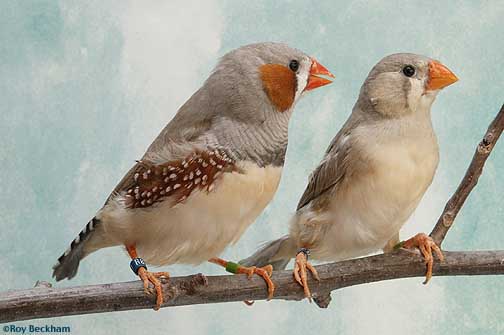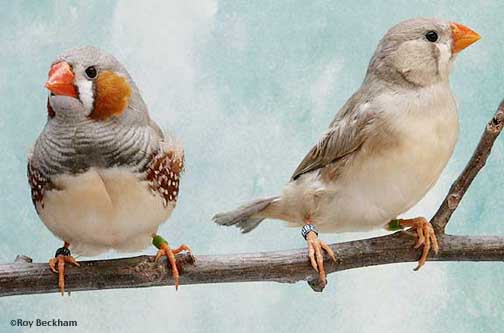




 |
|
|||||||||||||||||||||
 |
|
|
|
|
|
|
|
|
|
|||||||||||||
|
|
|
|
|
|
||||||||||||||||||
|
|
|
|
|
|
|
|
|
|
||||||||||||||
|
|
|
|
|
|
||||||||||||||||||
|
|
|
|
|
|
|
|
|
|
||||||||||||||
|
|
|
|
|
|
||||||||||||||||||
|
|
|
|
|
|
|
 |
|
|||||||||||||||
 |
 |
|
||||||||||||||||||||
|
|
|
|
||||||||||||||||||||
|
|
|
|
|
|
|
|
|
|
|
|
|
|
|
|
|
|
|
|
|
|
|
|
| Recessive Silver Zebra Finch | |||||
 |
|||||
| Recessive Silver male courting a Recessive Silver hen. | |||||
|
Mutation Effects Male: The Recessive Silver mutation causes all of the base gray color to dilute to a lighter, silvery color. The black markings are diluted an equal amount, but remain distinct from the base color. Overall, the mutation works to reduce the grays and blacks (eumelanin) by a "notch" or two. The orange colors of the cheek patch and flanks (phaeomelanin) remain at full strength. Female: As in the male, the base gray color is diluted and so are the black markings of the tail and tear mark. These are diluted to the same degree as the male. Fledgling: Recessive Silver chicks can be identified as soon as they feather out in the nest. They will have diluted feathers and look much like the hens. Combinations Since Recessive Silver is a dilute mutation, it is best not to combine it with other mutations that cause a further dilution of the colors. This means it should not be combined with CFW , Fawn Cheek, Florida Fancy, Dominant Silver and White. Other mutations that should be avoided in combination with Recessive Silver include those mutations that require contrasts to be appealing such as Penguin.
Notes The Recessive Silver mutation is not seen very much these days or at least not that birds can be identified with any certainty and separated from some of the other dilute silver varieties (Dominant Silver and Florida Silvers). With the popularity of the Florida Fancy, the Rec. Silver is giving way to the Florida Silvers and I suspect that most birds showing this type of dilution these days in the US are Florida Silvers. It used to be that the Rec. Silver was quite common in colonies of Zebras. |

